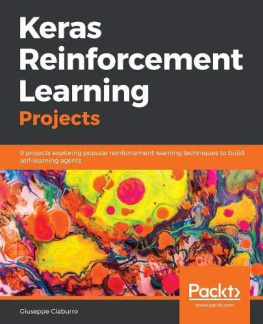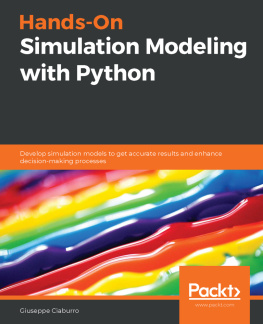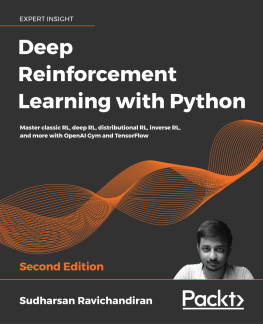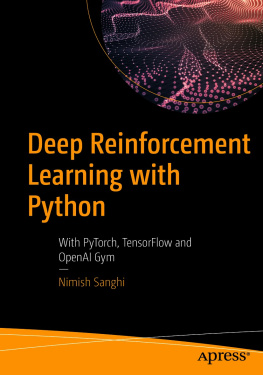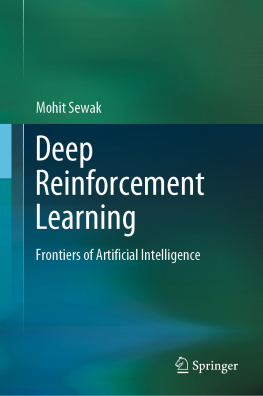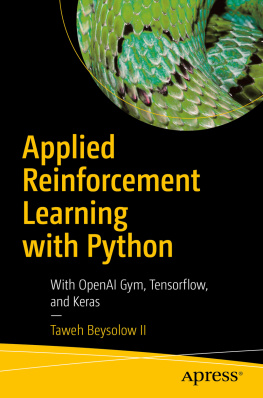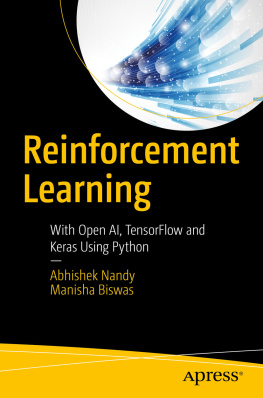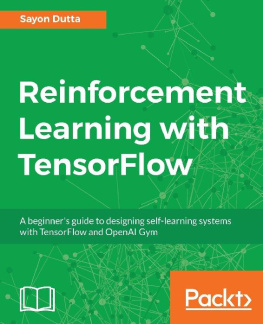Giuseppe Ciaburro - Keras Reinforcement Learning Projects
Here you can read online Giuseppe Ciaburro - Keras Reinforcement Learning Projects full text of the book (entire story) in english for free. Download pdf and epub, get meaning, cover and reviews about this ebook. year: 2018, publisher: Packt Publishing, genre: Computer. Description of the work, (preface) as well as reviews are available. Best literature library LitArk.com created for fans of good reading and offers a wide selection of genres:
Romance novel
Science fiction
Adventure
Detective
Science
History
Home and family
Prose
Art
Politics
Computer
Non-fiction
Religion
Business
Children
Humor
Choose a favorite category and find really read worthwhile books. Enjoy immersion in the world of imagination, feel the emotions of the characters or learn something new for yourself, make an fascinating discovery.
- Book:Keras Reinforcement Learning Projects
- Author:
- Publisher:Packt Publishing
- Genre:
- Year:2018
- Rating:5 / 5
- Favourites:Add to favourites
- Your mark:
Keras Reinforcement Learning Projects: summary, description and annotation
We offer to read an annotation, description, summary or preface (depends on what the author of the book "Keras Reinforcement Learning Projects" wrote himself). If you haven't found the necessary information about the book — write in the comments, we will try to find it.
A practical guide to mastering reinforcement learning algorithms using Keras
Key Features- Build projects across robotics, gaming, and finance fields, putting reinforcement learning (RL) into action
- Get to grips with Keras and practice on real-world unstructured datasets
- Uncover advanced deep learning algorithms such as Monte Carlo, Markov Decision, and Q-learning
Reinforcement learning has evolved a lot in the last couple of years and proven to be a successful technique in building smart and intelligent AI networks. Keras Reinforcement Learning Projects installs human-level performance into your applications using algorithms and techniques of reinforcement learning, coupled with Keras, a faster experimental library.
The book begins with getting you up and running with the concepts of reinforcement learning using Keras. Youll learn how to simulate a random walk using Markov chains and select the best portfolio using dynamic programming (DP) and Python. Youll also explore projects such as forecasting stock prices using Monte Carlo methods, delivering vehicle routing application using Temporal Distance (TD) learning algorithms, and balancing a Rotating Mechanical System using Markov decision processes.
Once youve understood the basics, youll move on to Modeling of a Segway, running a robot control system using deep reinforcement learning, and building a handwritten digit recognition model in Python using an image dataset. Finally, youll excel in playing the board game Go with the help of Q-Learning and reinforcement learning algorithms.
By the end of this book, youll not only have developed hands-on training on concepts, algorithms, and techniques of reinforcement learning but also be all set to explore the world of AI.
What you will learn- Practice the Markov decision process in prediction and betting evaluations
- Implement Monte Carlo methods to forecast environment behaviors
- Explore TD learning algorithms to manage warehouse operations
- Construct a Deep Q-Network using Python and Keras to control robot movements
- Apply reinforcement concepts to build a handwritten digit recognition model using an image dataset
- Address a game theory problem using Q-Learning and OpenAI Gym
Keras Reinforcement Learning Projects is for you if you are data scientist, machine learning developer, or AI engineer who wants to understand the fundamentals of reinforcement learning by developing practical projects. Sound knowledge of machine learning and basic familiarity with Keras is useful to get the most out of this book
Table of Contents- Overview of Keras Reinforcement Learning
- Simulating random walks
- Optimal Portfolio Selection
- Forecasting stock market prices
- Delivery Vehicle Routing Application
- Prediction and Betting Evaluations of coin flips using Markov decision processes
- Build an optimized vending machine using Dynamic Programming
- Robot control system using Deep Reinforcement Learning
- Handwritten Digit Recognizer
- Playing the board game Go
- What is next?
**
Giuseppe Ciaburro: author's other books
Who wrote Keras Reinforcement Learning Projects? Find out the surname, the name of the author of the book and a list of all author's works by series.

